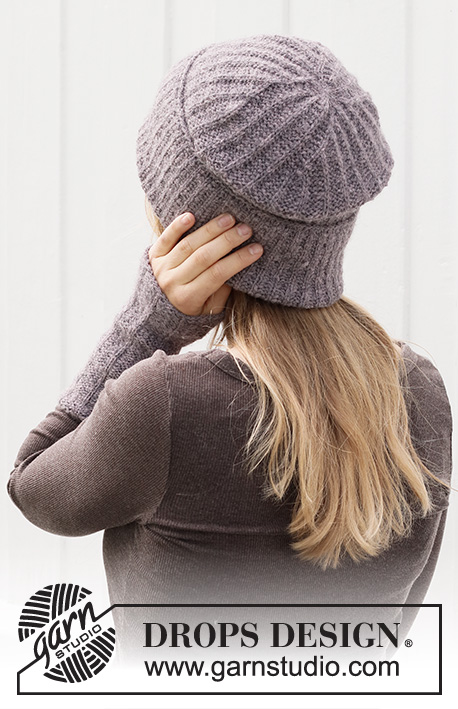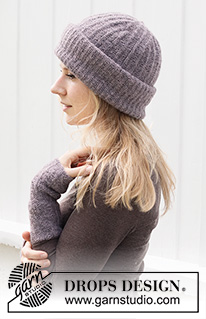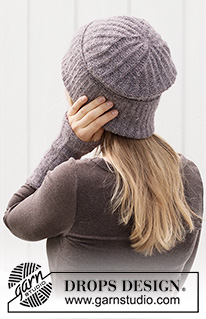Comments / Questions (14)
![]() Pam wrote:
Pam wrote:
Hello, I am not understanding why there is a wrong side in this pattern. If it’s knit in the round every row is the right side? I’ve read some of the other comments which seem to imply that the orientation is vertical so maybe I’m not understanding that. Is there a idea explaining this please? Thank you.
30.12.2024 - 19:13
![]() Lourdes wrote:
Lourdes wrote:
Hola Llegue a la parte de las disminuciones del gorro, cuando leo los tips de disminución resultan 2 puntos disminuidos en cada vuelta, pero en las indicaciones dice que se disminuyen 4. No lo comprendo. Que estoy haciendo mal? Gracias
28.05.2023 - 07:51DROPS Design answered:
Hola Lourdes, se disminuye 1 punto antes y 1 punto después de cada marcapuntos, tal y como se indica en el TIP-1 PARA LAS DISMINUCIONES. Como tienes dos marcapuntos en la vuelta, entonces trabajas las disminuciones 2 veces en la vuelta = 4 disminuciones en total.
28.05.2023 - 19:02
![]() Jacqui wrote:
Jacqui wrote:
I’m having a problem with decreasing on the hat. I decrease on the k/p row as instructed but in the next row, knitting the English/fisherman stitch into the row below (where that stitch is one of the reduced ones), causes me to have a dropped/loose stitch. Can you please explain what I need to do to avoid this? Thanks!
26.02.2023 - 15:51DROPS Design answered:
Dear Jacqui, on next round make sure you are inserting the needle into all stitches from previous round to avoid loosing one of the decreased stitches. Happy knitting!
27.02.2023 - 10:54
![]() Elin wrote:
Elin wrote:
Kan ni skriva hur man ska sticka varven från varv 2. Är det så här varv2 1 rät, 1 rät upprepa Varv 3 1 rät 1 avig upprepa Varv4 1 patent 1 rät upprepa
21.05.2022 - 19:18DROPS Design answered:
Hei Elin. Tenker du på luen eller pulsvantene? Luen strikkes rundt og pulsvantene strikkes frem og tilbake, og når du strikker etter diagram, husk å lese diagramikon forklaringen til hvordan maskene skal strikkes (patentmasken strikkes ulikt på luen og pulsvantene). Når det strikkes RÄTSTICKNING er det også forskjellige forklaringer på om det strikkes luen eller pulsvarmere. Forklaringen står øverst i oppskriften. mvh DROPS Design
23.05.2022 - 08:59
![]() Ellie wrote:
Ellie wrote:
What does it mean from the first Garter Stitch? Sorry I still don't get it. A chart is read from right to left and left to right on the next row (purl row). Why your pattern is written vertically? Instead of repeating the same exact thing it is written in the pattern, can you explicitly express, like Knit All, Knit 1, Purl all row in the third, etc. Can't understand. I've read some patterns and your pattern is impossible to understand, especially this one.
20.01.2022 - 18:57DROPS Design answered:
Dear Ellie, correct, you have to repeat the stitches between * and * all around the round, and repeat these rounds as shown in the chart - maybe this lesson could help you better?
21.01.2022 - 09:07
![]() Ellie Wakamatsu wrote:
Ellie Wakamatsu wrote:
Hat question: "When A.1 has been worked vertically, repeat the last 2 rounds in A.1.", what does it mean? Is it that I almost measure 14 cm for the rim portion before flipping it to inside out, the last 2 rounds in A1, so according to the pattern, K, K1B four times, then K2, and I keep doing that an entire row, then do the purl version. I do that 2 times (Garter Stitch, meaning 2 rows of knit and purl of a ridge?) for 4 rows (knit, purl x 2 Garter stitch/ridge rows)?
20.01.2022 - 13:53DROPS Design answered:
Dear Mrs Wakamatsu, this means you will repeat the round 3 and 4 described in the previous answer; and yes, work until piece measures 14 cm before flipping inside out and work : 3 sts in garter st (alternately K or P in height) and A.1 as previously. Hope this will help. Hpapy knitting!
20.01.2022 - 17:16
![]() Ellie wrote:
Ellie wrote:
Hi, can you please confirm if I understand this part of this hat pattern correctly? * A.1 (= 1 stitch), 1 stitch in GARTER STITCH - read explanation above * This above line means, A1, first so I do Knit, Knit one below four times, knit 2. Is this correct? What does it mean 1 stitch in Garter stitch? You mean knit in pattern (K, K1B x 4, K2), then on the next is purl row, since it is Garter stitch, so the pattern would look (P, P1B x4, P2)?
20.01.2022 - 13:44DROPS Design answered:
Dear Ellie, on first round repeat: *A.1 (= K1), 1 st in garter st (= K1)*; on 2nd round, repeat *A.1 (= K1), 1 st in garter st (= P1)*, on 3rd round repeat *A.1 (= Knit 1 below), 1 st in garter st (= K1)*, on 4rd round repeat *A.1 (= K1), 1 st in garter st (= P1)*. Repeat then round 3 and 4. Happy knitting!
20.01.2022 - 17:13
![]() Ruta wrote:
Ruta wrote:
Już widzę, że robiłam źle robiąc na około, proszę skasować mój poprzedni komentarz
25.12.2021 - 21:35
![]() Ruta wrote:
Ruta wrote:
Widzę, że na zdjęciu są 2 oczka lewe i 1 oczko ściegiem angielskim, w opisie jest błąd, to niemożliwe, żeby powstał wzór że zdjęcia robiąc 1 oczko prawe, 1 oczko ściegiem angielskim, a kolejny rząd wszystkie prawe. Właśnie robię według opisu i wychodzi zupełnie co innego,vdo tego brzeg się podwija. Czy nie powinno być 2 oczka lewe, 1 ściegiem angielskim, a w kolejnym rzędzie wszystko na prawo?
25.12.2021 - 19:29DROPS Design answered:
Witaj Ruto, tylko zakładka na dole czapki jest przerabiana jako 1 oczko ściegiem francuskim, A.1, itd. Dalsza część czapki jest przerabiana następująco: ‘Dalej przerabiać w przeciwnym kierunku następująco: *3 oczka ściegiem francuskim, schemat A.1 (= 1 oczko) *,… Pozdrawiamy!
27.12.2021 - 13:53
![]() Katu wrote:
Katu wrote:
Die deutsche Anleitung hat Fehler wie zum Beispiel dass auf einmal häken auftaucht anstatt stricken. Es ist ein einziges Chaos und ich musste auf die englische Anleitung zurück greifen um zu begreifen, was gemeint ist. Schrecklich und wirklich schade, das versaut die Lust die Mütze zu stricken.
13.11.2021 - 20:31DROPS Design answered:
Guten Morgen, die Stellen mit "häkeln" statt "stricken" wurden korrigiert. Ansonsten wären wir Ihnen dankbar für weitere konkrete Hinweise, an welchen Stellen genau Sie Probleme mit der Anleitung haben und wo Sie die Anleitung als "Chaos" empfinden und auf die englische Version zurückgreifen mussten - an sich entspricht die Anleitung nämlich unseren üblichen Formulierungen, aber wir möchten uns natürlich bemühen, so verständlich wie möglich zu sein. Gutes Gelingen mit Ihrer Mütze!
15.11.2021 - 09:09
Chill of Dawn#chillofdawnset |
||||||||||
 |
 |
|||||||||
Knitted beanie / hipster hat and wrist warmers in DROPS Sky with garter stitch and English rib stitch.
DROPS 214-15 |
||||||||||
|
------------------------------------------------------- EXPLANATION FOR THE PATTERN: ------------------------------------------------------- GARTER STITCH (worked in the round): 1 ridge vertically = 2 rounds, i.e. knit 1 round and purl 1 round. GARTER STITCH (back and forth): Knit all rows. 1 ridge vertically = knit 2 rows. PATTERN: Hat: See diagram A.1. Wrist warmers: See diagram A.2. Diagrams show all rows in pattern seen from the right side. DECREASE TIP-1 (applies to hat): Decrease on rounds that are last round in A.1 as follows: Decrease as follows after marker: Work stitch with marker and the next 7 stitches as before, slip 1 stitch knitwise, knit 1, pass slipped stitch over (= 1 stitch decreased). Decrease as follows before marker: Work until 9 stitches remain before marker, knit the next 2 stitches together (= 1 stitch decreased) DECREASE TIP-2 (applies to wrist warmers): Decrease 1 stitch by knitting 2 together from right side. INCREASE TIP (applies to wrist warmers): Increase 1 stitch by making 1 yarn over. On next row, knit yarn over twisted to avoid hole. CAST-OFF TIP: To avoid a tight cast-off edge you may use a larger needle size. If this also is too tight, work a 1 yarn over after approx. every 4th stitch while casting off (cast off yarn overs as regular stitches). ------------------------------------------------------- START THE PIECE HERE: ------------------------------------------------------- HAT - SHORT OVERVIEW OF THE PIECE: Work in the round on a short circular needle. Switch to double pointed needles when needed. HAT: Cast on 104-112 stitches on a circular needle size 3.5 mm with Sky. Knit 1 round. Then work pattern as follows: * A.1 (= 1 stitch), 1 stitch in GARTER STITCH - read explanation above *, work from *-* the entire round. REMEMBER THE KNITTING TENSION! When A.1 has been worked vertically, repeat the last 2 rounds in A.1. When piece measures 14 cm, turn piece so that wrong side is outwards (this is done so that right side of folding edge is turned outwards at the end when hat is finished). Insert a marker here. NOW MEASURE PIECE FROM HERE! Then work pattern in the in opposite direction as follows: * 3 stitches in garter stitch, A.1 (= 1 stitch) *, repeat from *-* the entire round. When piece measures 14-15 cm from marker, insert 2 new markers in piece as follows: Insert first marker in the first English rib stitch on round, skip the next 51-55 stitches and insert next marker in the next stitch (= 51-55 stitches between stitches with marker). On next round begin decrease - read DECREASE TIP-1 (= 4 stitches decreased). Decrease like this every other round 16-18 times = 40-40 stitches. Then work in stocking stitch and decrease as follows: ROUND 1: * Knit 2, knit 2 together (= 1 stitch decreased) *, work from *-* the entire round (= 10 stitches decreased) = 30-30 stitches. ROUND 2: Knit 1 round. ROUND 3: Knit stitches together 2 by 2 = 15-15 stitches. Cut the yarn and pull it through the remaining stitches, tighten together and fasten. Hat measures approx. 24-26 cm with 12 cm fold at the bottom. ------------------------------------------------------- WRIST WARMERS - SHORT OVERVIEW OF THE PIECE: Work back and forth on circular needle, and sew together. WRIST WARMERS: Cast on 43-47 stitches on a circular needle size 3.5 mm with Sky. Work pattern as follows (1st row = right side): Work 11-13 stitches in GARTER STITCH – read explanation above, * A.2 (= 1 stitch), 4 stitches in garter stitch *, work from *-* 4 times in total, A.2 over next stitch, 11-13 stitches in garter stitch. Continue back and forth like this. REMEMBER THE KNITTING TENSION! When A.2 has been worked vertically, repeat the last 2 rows in diagram until finished measurements, and when piece measures 4 cm decrease 2 stitches on row as follows: Work 3 stitches in garter stitch as before, decrease 1 stitch – read DECREASE TIP-2, work as before until there is 5 stitches left on row, decrease 1 stitch, work 3 stitches garter stitch as before. Repeat decrease when piece measures 6 cm = 39-43 stitches. When piece measures 8 cm, decrease 1 stitch in garter stitch in every section with 4 stitches in garter stitch = 35-39 stitches. Work until piece measures 14 cm. Now increase 2 stitches on row as follows: Work 3 stitches in garter stitch as before, increase 1 stitch – read INCREASE TIP, work as before until there are 3 stitches left on row, increase 1 stitch, work 3 stitches in garter stitch as before. Repeat increase when piece measures 18 cm = 39-43 stitches. Continue like this until piece measures 22 cm. Cast off by knitting from wrong side - read CAST-OFF TIP. Cut the yarn but leave some yarn for assembly. Sew seam inside 1 edge stitch in garter stitch. Work the other wrist warmer the same way. |
||||||||||
Diagram explanations |
||||||||||
|
||||||||||

|
||||||||||
Have you finished this pattern?Tag your pictures with #dropspattern #chillofdawnset or submit them to the #dropsfan gallery. Do you need help with this pattern?You'll find 19 tutorial videos, a Comments/Questions area and more by visiting the pattern on garnstudio.com. © 1982-2025 DROPS Design A/S. We reserve all rights. This document, including all its sub-sections, has copyrights. Read more about what you can do with our patterns at the bottom of each pattern on our site. |
||||||||||































































Post a comment to pattern DROPS 214-15
We would love to hear what you have to say about this pattern!
If you want to leave a question, please make sure you select the correct category in the form below, to speed up the answering process. Required fields are marked *.